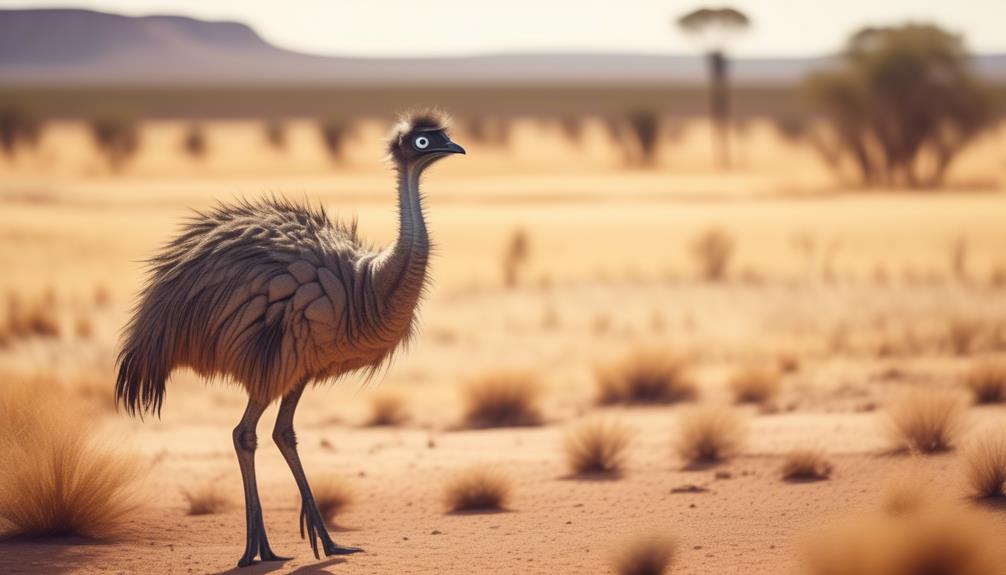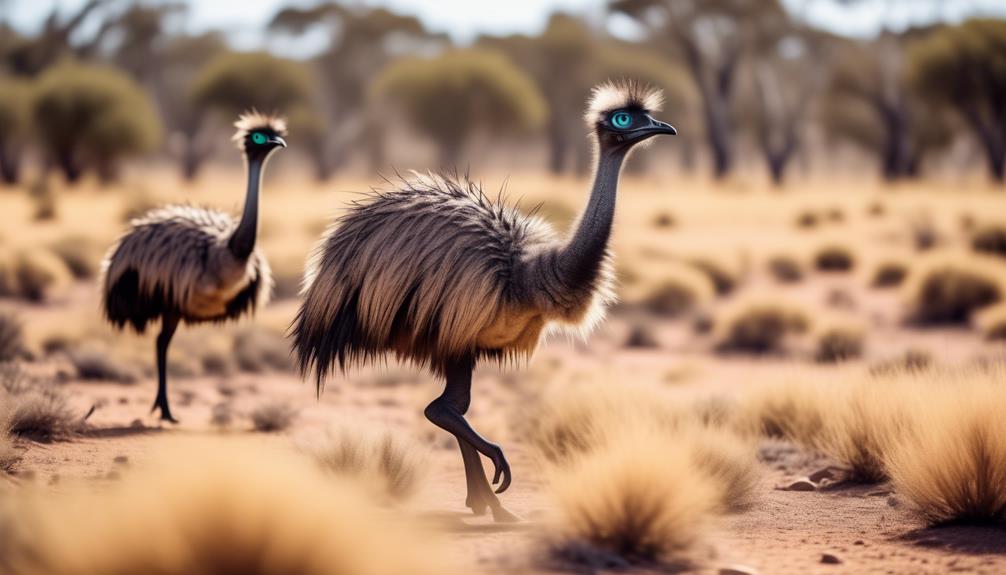
Have you ever wondered how emus, those flightless birds native to Australia, have managed to survive and thrive in some of the harshest environments on Earth?
Well, it turns out that emus are masters of adaptation, and there are valuable lessons we can learn from them. From their physical attributes to their behavioral strategies, emus have developed remarkable techniques to overcome challenges and ensure their survival.
But what can these fascinating creatures teach us about our own ability to adapt and thrive in an ever-changing world?
Let's explore the world of emus and discover the secrets of their remarkable adaptation and resilience.
Key Takeaways
- Emus demonstrate adaptability in various environments, including urban areas, by navigating busy streets and parks and foraging for food in available resources.
- Emus' physical attributes, such as their exceptional camouflage techniques, long legs, and powerful feet, contribute to their survival in challenging environments.
- Emus exhibit behavioral strategies, such as forming family groups, communicating through vocalizations and body language, and adjusting their feeding patterns, to adapt to changing conditions.
- Emus' diverse diet, ability to sense nutritional content, and specialized digestive system provide insights for optimizing human resilience and adapting to food shortages.
Emus: Masters of Adaptation

Emus have proven themselves to be masters of adaptation, continually displaying their remarkable ability to thrive in various environments and overcome challenges. This is evident not only in their natural habitats but also in captivity and urban environments.
In captivity, emus have shown a remarkable ability to adjust to their new surroundings. They can adapt to different diets, including commercial feeds, and have been successfully bred in captivity for conservation purposes. Emus in captivity are known to form social bonds with their human caretakers, demonstrating their ability to adapt to new social structures.
Emus have also proven their adaptability in urban environments. As cities grow and encroach upon their natural habitats, emus have managed to carve out niches for themselves within these urban landscapes. They can navigate busy streets, parks, and even backyards, adapting to urban noise and traffic. Emus have been observed foraging for food in parks and gardens, making use of the resources available to them.
Physical Attributes for Survival
Possessing a range of physical attributes, emus have evolved to ensure their survival in diverse environments. One key attribute is their exceptional camouflage techniques, which allow them to blend seamlessly into their surroundings and avoid detection by predators. Emus have coarse, shaggy feathers that help them blend in with the scrublands and grassy plains they inhabit. Their feathers are a mottled brown color, which provides effective camouflage against the earthy tones of their environment. Additionally, their long legs and necks enable them to keep a low profile, further enhancing their ability to hide in plain sight.
Another physical attribute that contributes to the emus' survival is their climate resilience. These birds are well-adapted to withstand extreme temperatures, both hot and cold. They've a unique circulatory system that allows them to regulate their body temperature efficiently, preventing overheating in hot climates and conserving heat in cold climates. Emus also possess large, powerful feet that enable them to walk long distances in search of food and water, even in arid environments.
Behavioral Strategies in Challenging Environments

With their physical attributes ensuring their survival in diverse environments, emus also employ behavioral strategies to navigate challenging conditions. In challenging environments, emus exhibit complex social dynamics that contribute to their ability to adapt and survive. They form small family groups that consist of a dominant male, several females, and their offspring. This social structure allows for cooperation and protection, as well as shared responsibilities in raising the young. Emus also engage in vocalizations and body language to communicate within their groups, helping them coordinate activities and alerting each other to potential dangers.
Another crucial behavioral strategy that emus employ is cognitive flexibility. They have the ability to adapt their behaviors based on the changing conditions of their environment. For example, emus can adjust their feeding patterns depending on the availability of food sources. In times of scarcity, they may switch to a more opportunistic feeding strategy, consuming a wider range of plant materials. This cognitive flexibility enables emus to exploit different resources and adapt to varying environmental conditions, enhancing their chances of survival.
The Role of Diet in Emu Survival
How does the diet of emus contribute to their survival in challenging environments?
Emus, as herbivorous birds, have specific nutritional requirements that play a crucial role in their ability to adapt and survive in diverse habitats. Their feeding habits enable them to obtain the necessary nutrients to maintain their health and resilience in challenging conditions.
Emus primarily feed on plants, consuming a variety of vegetation including grasses, fruits, seeds, and leaves. This diverse diet allows them to meet their nutritional needs, providing essential vitamins, minerals, and energy required for their survival. Their ability to consume a wide range of plant species gives them an advantage in environments where food availability may be limited.
Feeding habits also contribute to the emus' survival by allowing them to adapt to changing conditions. These birds have a unique ability to sense the nutritional content of plants, enabling them to select the most suitable food sources. This adaptability allows emus to adjust their diet according to the availability of different plants throughout the year or in different habitats.
Furthermore, emus have a specialized digestive system that helps them efficiently process their food. They possess a large cecum, which acts as a fermentation chamber, aiding in the breakdown of plant material and extraction of nutrients. This adaptation enables emus to maximize their nutrient intake from their diet, ensuring their survival even in harsh environments with limited food resources.
Lessons From Emus for Human Adaptation and Resilience

Emus' adaptive feeding habits and specialized digestive system offer valuable lessons for human adaptation and resilience.
These flightless birds have evolved to thrive in a harsh and unpredictable environment, providing insights into how we can navigate adversity. Emus possess remarkable resilience in the face of challenges, a trait that humans can learn from.
Their ability to adapt their feeding habits to different food sources showcases their flexibility and resourcefulness. Emus can consume a wide range of plants, insects, and even small vertebrates, enabling them to survive in diverse habitats. This adaptability is crucial in times of scarcity or environmental change, as it allows emus to find alternative sources of nutrition and overcome adversity.
Furthermore, emus' specialized digestive system plays a pivotal role in their survival. Their unique gastrointestinal tract enables efficient processing of food and extraction of nutrients. Humans can draw inspiration from this adaptation by exploring ways to optimize our own digestive systems for better resilience.
Emus' ability to extract nutrition from a variety of food sources highlights the importance of diversifying our diets to enhance our resilience against potential food shortages or changes in availability. By learning from nature and emulating the strategies employed by these remarkable creatures, humans can develop the adaptability and resilience needed to thrive in the face of adversity.
Frequently Asked Questions
Are Emus Found in Specific Regions or Are They Distributed Globally?
Emus are found in specific regions, such as Australia and Indonesia. Their distribution is not global. However, they have a significant impact on the ecosystem due to their unique physical adaptations.
How Long Do Emus Typically Live in the Wild?
Emus in the wild typically live for about 10 to 20 years. However, in captivity, they can live up to 35 years. This difference in lifespan is due to various factors such as access to food, shelter, and protection from predators. Emu breeding habits also play a role in their survival.
Do Emus Have Any Natural Predators?
Emus, unlike other birds, face unique survival challenges due to their size and inability to fly. They have adapted to survive in a predator-rich environment, relying on their speed and powerful legs to escape potential threats.
How Do Emus Communicate With Each Other?
Emus communicate with each other through a combination of vocalizations and body language. Their vocalizations include deep booming sounds and drum-like beats, while their body language involves displays of aggression, submission, and courtship.
Are There Any Specific Challenges or Threats That Emus Face in Their Natural Habitat?
In their natural habitat, emus face specific challenges such as predation, scarcity of food and water, and extreme weather conditions. Human activities, such as habitat destruction and hunting, have also had a significant impact on emu populations.
Conclusion
In conclusion, emus demonstrate remarkable adaptability and resilience in the face of challenging environments. Their physical attributes, behavioral strategies, and diet all contribute to their survival.
Studying these fascinating creatures provides valuable insights for human adaptation and resilience. By observing and learning from the emus' methods, we can better equip ourselves to navigate and thrive in our own ever-changing world.




